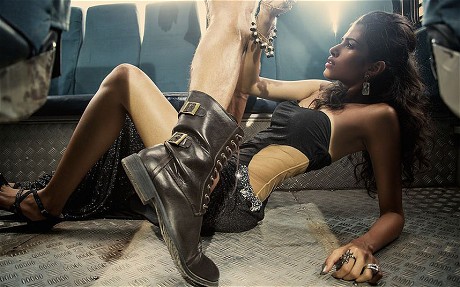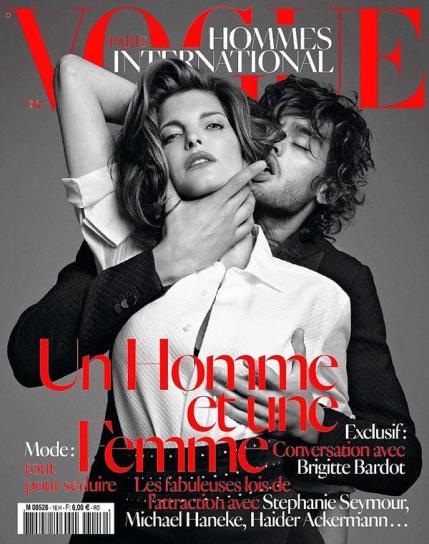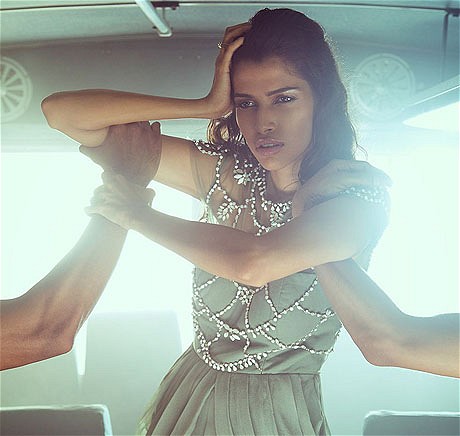Why? ‘The Wrong Turn’, as it’s called, depicts a young, glamorously dressed, Indian woman on a bus, posing being groped and manhandled by a gang of men. In one image she holds her head, while two men attempt to pull her arms apart. In another she’s straddled by a man seemingly naked, but for a pair of boots. A particularly controversial shot shows the model being held in a grip lock by one man, while another pulls her bare leg from her long dress and appears to be kissing her knee.
Needless to say, it’s not a huge leap to associate the posed images with the brutal gang rape and murder of a 23-year-old student on a bus in New Delhi, in December 2012. The crime shocked India, started an unprecedented debate on the vulnerability of women to sexual assault and led to days of protests, which forced authorities to introduce tough new anti-rape laws. Four of the perpetrators were eventually sentenced to death.

The Mumbai based photographer has denied that his work depicts the exact circumstances of the crime, which Indians refer to by the pseudonym given to the victim; ‘Nirbhaya, a Hindi word meaning ‘fearless’.
But he has admitted that he intended to restart the conversation around the issue of women’s safety.
“This is in no way meant to glamorise the act, which was very bad,” Shetye told BuzzFeed. “It’s just a way of throwing light on it.”
“But being a part of society and being a photographer, that topic moves me from inside,” he continued. “I stay in a society where my mother, my girlfriend, my sister are out there and something like this can happen to them also.”
Shetye claims to have spent months perfecting the idea for the shoot, as he didn’t want to “create something irresponsible”. He also said that none of the fashion brands used has been credited, to avoid accusations of commercialisation.
The reaction to his photos on Twitter and Facebook, however, suggests that he’s well and truly failed in his mission.
The images are called ‘repulsive’, ‘digusting’, ‘sickening’ and ‘horrific’. Most users are outraged at what they see as commercial gain from crime. Some accuse him of seeking publicity. Many ask what victims of rape will think when they see the photos. Only a handful have come out in support of Shetye and posited that his title, ‘The Wrong Turn’ is in itself a comment on how society has lost its way when incidents like this can happen in the first place.
Sapna Moti Bhavnani, a Bollywood actress who took part in a recent stage production based on the gang-rape, wrote:
Bollywood director Vishal Dadlani said:
While New Delhi-based author Meenakshi Medhavan called it ‘tasteless’:

She then went on to post a series of fashion shots that depict models being choked, harrassed by policemen and murdered.
It brings to mind Vice magazine’s much criticised 2013 ‘Last Words’ shoot, in which models posed as famous female writers who committed suicide – at the moments of their death. In that instance, the fashion brands featured were named, while no information was given on the authors (think Sylvia Plath, Virginia Woolf) themselves. Such was the outcry that Vice deleted the pictures from its site and apologised “to anyone who was hurt or offended.”
So furious has been the backlash against Shetye that he was forced to explain himself on Facebook and has removed the original images from his website.

The artist allegedly wrote; ‘It is meant to highlight our double standards where people expect the rich or well-heeled to dress well and travel in the luxury security and comfort of their own vehicle…It was intentionally done in a bus to cause men to think of what gives them the right to assume that well dressed women in public transport (signifying public spaces in general) can be targets & also what gives the general public the right to cast aspersions on women and their character if they are well dressed and seen in public.’
But he also admitted that the reaction, “makes me feel satisfied about my work — at least the work I did is so impactful that I’m able to shed some light on this. I don’t feel happy, but it makes me feel satisfied. That whatever I’ve tried to communicate is being communicated.”
So what exactly is being communicated here? Shetye claims that he wants to throw light on the subject of rape and start a conversation. Andin a statement, he wrote ‘If the cost to set the ball-rolling here is that I have [to] be the bad guy, then be it that way.’
But what is Shetye making himself the bad guy for? Because I question whether anything positive can come out of this. When has art – of the sort that depicts crime or criminals – ever really changed anything?
In the late Nineties, an image of Myra Hindley, by artist Marcus Harvey,provoked an extreme reaction and was defaced during the 1997 Royal Academy exhibition on the YBAs. In 1964, Warhol’s ‘Most Wanted’ series of mugshots caused outrage at the Woyld Fair.
While Vice’s photo shoot – and others like it – have caused mass upset and widespread comment. But did any of them actually add anything useful to the conversation around the crime, or criminals, they depicted?
Only this week a 20 year-old Hindu woman has said she was kidnapped and gang-raped over three days in India’s Uttar Pradesh region. And in May, two teenage girls were raped and hanged from trees in the north of the country.
Is Shetye going to use these latest crimes as the basis for further works? Does he believe that doing so would really add anything positive to the debate around the safety of women?
Or would it, as his latest photo shoot has, simply cause widespread distress and disgust.
Do you think these pictures add anything to the debate on rape in India?



